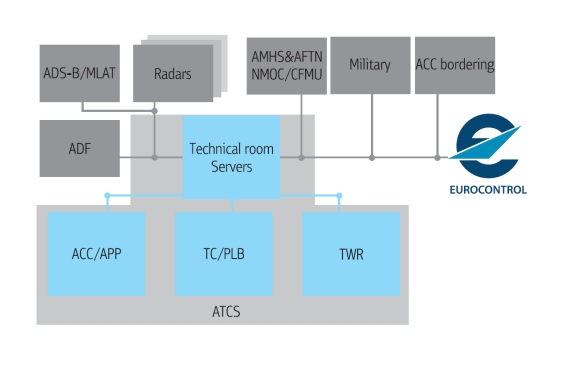Automated Air Traffic Control System (ATCS)
- Home
- ATC systems
- Automated Air Traffic Control System (ATCS)
Automated Air Traffic Control System (ATCS) is designed for reception, processing and display of surveillance and direction finding information, flight data and other information for the purpose of providing air traffic management services within the area of responsibility of Area Control Centre (ACC), Approach (APP), management of arrivals and departures by Aerodrome Control Tower (TWR) controllers.
ATCS incorporates features to improve air safery, increase airspace capacity and provide greater Controller efficiency while providing high performance and reducing controller workload.
Network and hardware configuration of ATCS excludes complete failure of system. Fault of a single element leads only to a decrease in efficiency. System recovery time, due to the use of aggregate spare parts, does not exceed 30 minutes.
Structure and reliability:
- placement of active working position equipment in a hardware room;
- reception of surveillance data and flight plans over main and standby data channels;
- data processing exchange and recording by server equipment with 100% redundancy;
- internal network exchange with 2 to 4 times data logical duplication;
- support of the Bypass procedure fro surveillance and flight data information;
- duplication of main server data processing and recording on the equipment of working porisiont (DARD, LOCAL).
Flight Data Processing (FDP):
- AFTN data exchange in ICAO, ADEXP formats;
- automatic IFPL fights plannign in FIR;
- automatic / manual correction of AFTN messages;
- automatic limitation of flight plans based on NOTAM and messages of the AS "CENTER" system;
- automatic (OLDI) and manual activation of flight plans, changing status of flight plans;
- automatic track - flight plan correlation, correction of flight route (track in accordance with flight plan);
- automatic cross-sector and external cordination;
- automatic distribution of flight plans.
- reception of surveillance data from PSR/SSR radars (digital and analogue through A1000 extractor), height-finders, ADS-B, multilateration systems, adjacent ATC units (OLDI);
- automatic error correction in range and azimuth;
- filtering of inaccurate data;
- mono and multi-radar processing of surveillance information by redundant RDP server;
- local DARD (in working positions), mono and multi-radar processing of surveillance information in Bypass network.
- operator interface meets Eurocontrol requirements;
- interface unification for all types of working positions;
- automatic and manual adaptation of the operator interface for the selected working positions status;
- system parameters access restriction;
- synchronous presentation on all working positions:
- maps, flight restriction areas;
- surveillance information;
- status of tracks and flight plans;
- indications of Safety Nets;
- advanced tools:
- multi-level individual meter;
- track according to flight plan;
- multilayer selective cartography;
- saving individual settings;
- color indication of track status;
- additional radar window;
- playback of recorded communication;
- Safety Nets:
- Short Term Conflict Alert (STCA);
- Minimum Safe Altitude Warning (MSAW);
- Area Proximity Warning (APW).
- Indication of:
- Approach Path Monitor (APM);
- Medium Term Conflict Detection (MTCD);
- route adherence monitoring;
- SSRCodes monitoring.
- automatic recording and storage:
- surveillance data and fligth plans;
- Ethernet and Bypass data;
- HMI of working positions;
- equipment status and user registration messages;
- voice communication;
- playback of recorded data:
- HMI of working positions (passive mode);
- interactive data playback (application of HMI);
- playback of voice;
- synchronous playback of HMI and voice;
- events evaluation by selected parameter (callsign, STCA, MSAW, APW, OLDI messages, etc.);
- statistical evaluation of radar data quality, generation of reports;
- storing recorded data on a removable media.
- operational and technical monitoring of equipment and processes;
- common time synchronization;
- automatic and manual switching of standby equipment;
- online reconfiguration and sectorisation;
- preparation nad entry of system parameters, settings, maps;
- remote monitoring of working position interface, equipment recovery;
- statistical evaluation of a selected radar sensor without system reconfiguration.
